As the quarter-finals of the 2024 UEFA European Championship approach, we have had our first real taste of an upset as defending champions Italy were dumped out of the competition by Switzerland. Murat Yakin led the Swiss to a second-place finish in Group A, winning one and drawing two. Their point total would have been enough to claim top spot in some other groups, but host nation Germany prevented Switzerland from clutching the number one spot.
Switzerland started the competition strongly, seeing off Hungary in a 3-1 victory. 1-1 draws to Scotland and Germany, respectively, secured their progression to the knockout phase. The latter result, in particular, turned a few heads as to just how good Yakin’s team can be. They proved that once again as they dispatched the reigning Euros champions in the round of 16.
This tactical analysis will provide insight into how Switzerland overcame Italy. It will focus on the key tactics used by Yakin’s team during that game that were also present and important in the three games prior. The analysis will focus on the following three key areas: midfield recoveries and counterpressing, off-the-ball movement in the final third, and chance creation via through passes.
Midfield recoveries & counterpressing
So far in this tournament, we’ve seen teams such as Germany and Austria deploy an aggressive approach off the ball with good results. As Total Football Analysis‘ own Selim Ben Hmida highlighted in our tactical preview of Switzerland prior to the competition, the Swiss have the ability to incorporate similar pressing tactics, but really, we haven’t seen as much of it this time around – their PPDA in this tournament so far sits at 12.91, whereas their PPDA over the last year comes in at 10.11. They have, however, still managed to utilise impressive defensive recovery in the midfield third, as well as executing a counterpress in certain areas and moments.
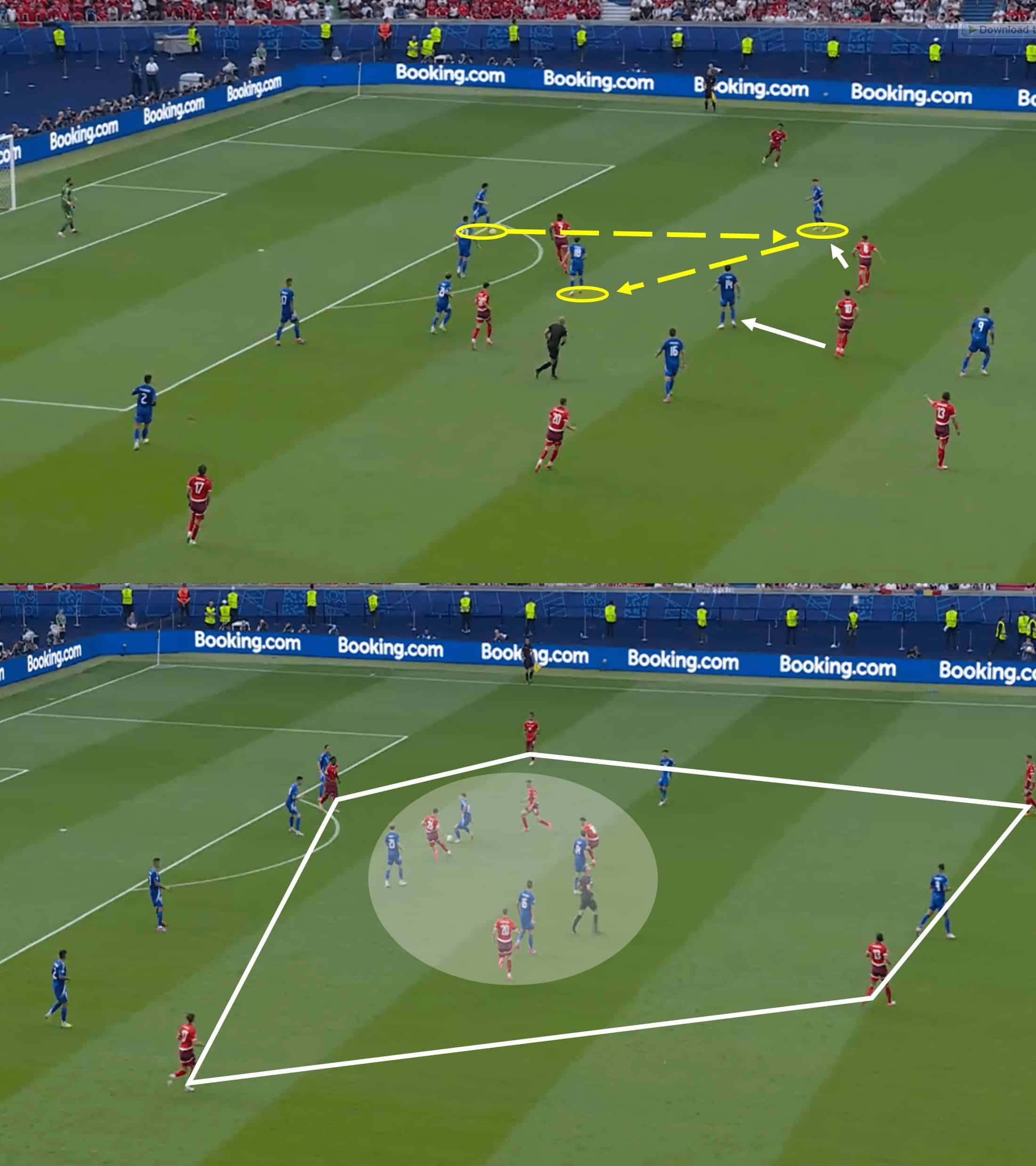
On more than one occasion in this tie, we saw Switzerland’s behaviour switch as they looked to swarm the Italians on the ball during a transition. Switzerland’s approach in possession allowed for a high presence in the opposition half, which lent itself to being ready to execute the counterpress in these moments.
Their counterpress is not just one or two players looking to react with intensity and aggression. As you can see from the example above, there is a collective effort in pressing the ball and marking the immediate passing options. Furthermore, the Swiss make sure they have players located around the outside of the core of the counterpress – this provides presence in extra areas and protects them if Italy did manage to bypass the counterpress.
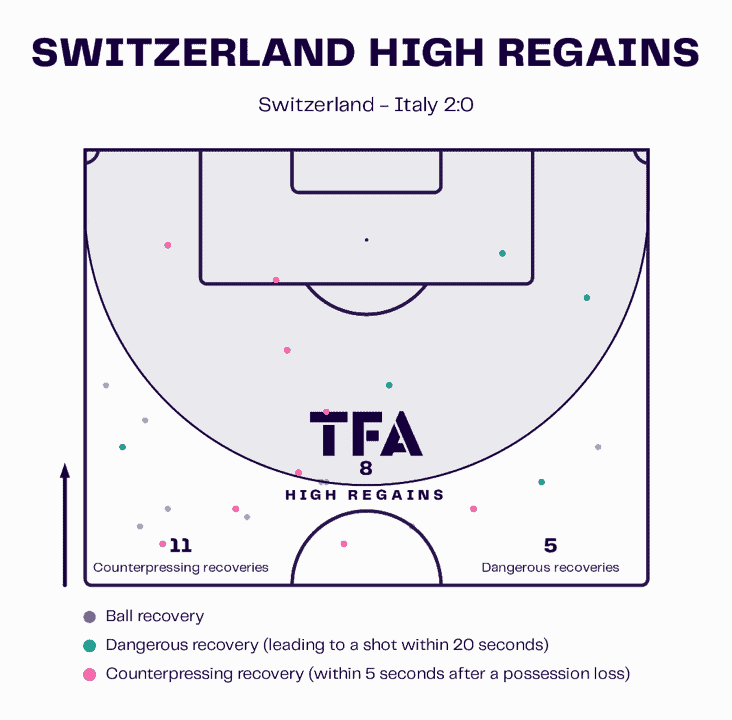
These numbers aren’t reflective of a high-intensity pressing team. And that is exactly the point we’re trying to make here – Switzerland pick their moments to up the pressure, and, as we discussed, it’s usually in transitional moments. More often than not, those counterpressing moments come in central areas for Switzerland as they can have a stronger presence in those areas without leaving themselves too exposed in other areas.
Switzerland have averaged 36.32 interceptions per 90, which indicates their strong positioning and reactions out of possession. That number is the fifth-highest in the whole competition currently.
Off-the-ball movement in the final third
Another thing that was mentioned in the tactical preview was Switzerland’s ability to capitalise on opposition mistakes and execute dangerous attacks and transitions. And to achieve that, they use lots of very good off-the-ball movement, particularly as they transition into the final third.
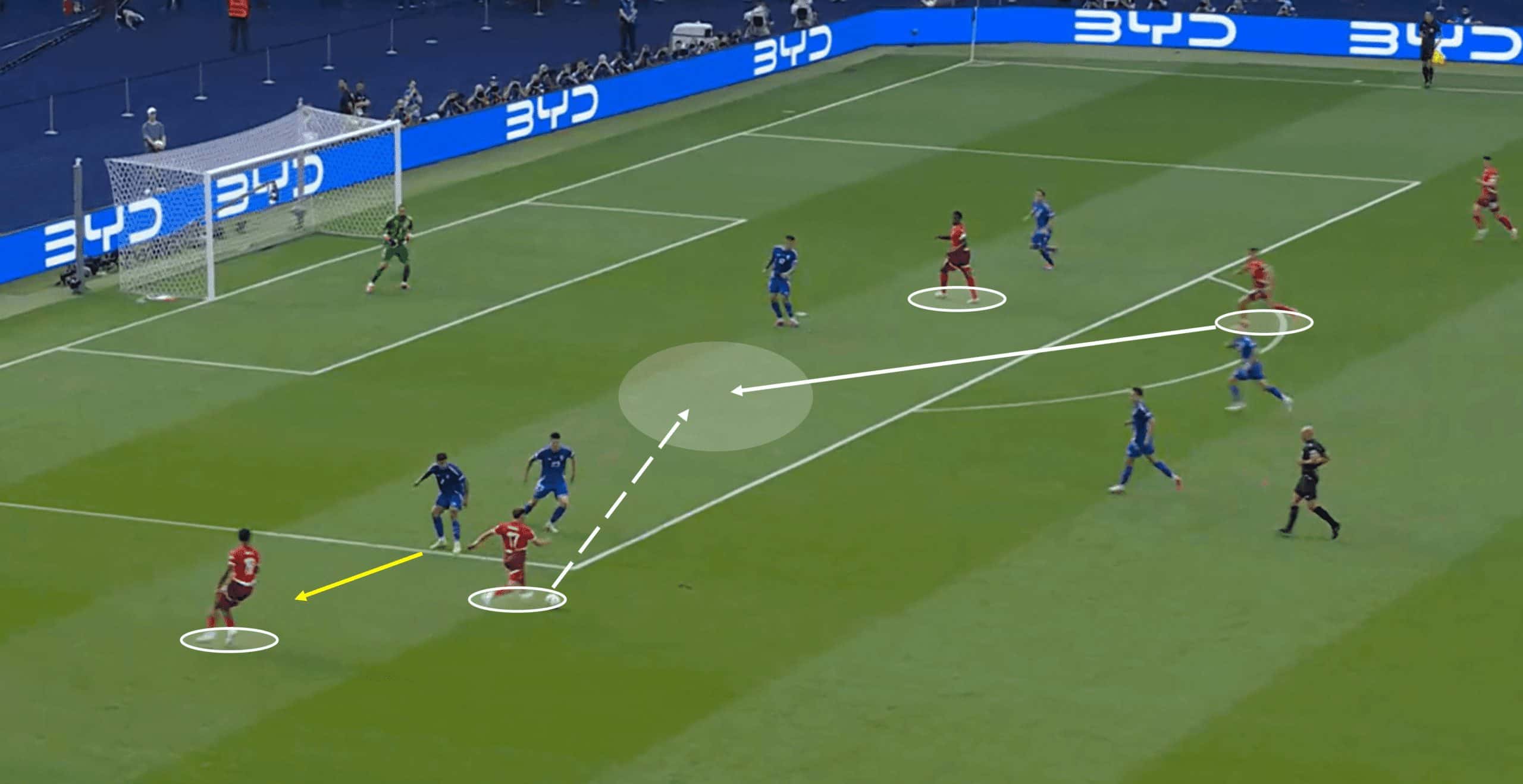
Italy’s defensive performance was far from good in this game. Up and down the pitch, there were moments, even small individual moments, that let them down and provided Switzerland with the chance to hurt them.
As we mentioned earlier, Switzerland have shown the ability to capitalise on weak opposition moments, reacting with courage and attacking intensity when it counts. A wide shape in attack was not uncommon for Yakin’s side as they looked to stretch Italy in order to create exploitable space in dangerous areas.
You may recognise the shot above, as it came just seconds before Switzerland took the lead. The attack was the pinnacle of a well-executed attacking transition, which included a quick line-breaking back from defence that ultimately enabled the Swiss to wind up in the position in the image above. From there, they rely on clever individual movement and a quality end product.
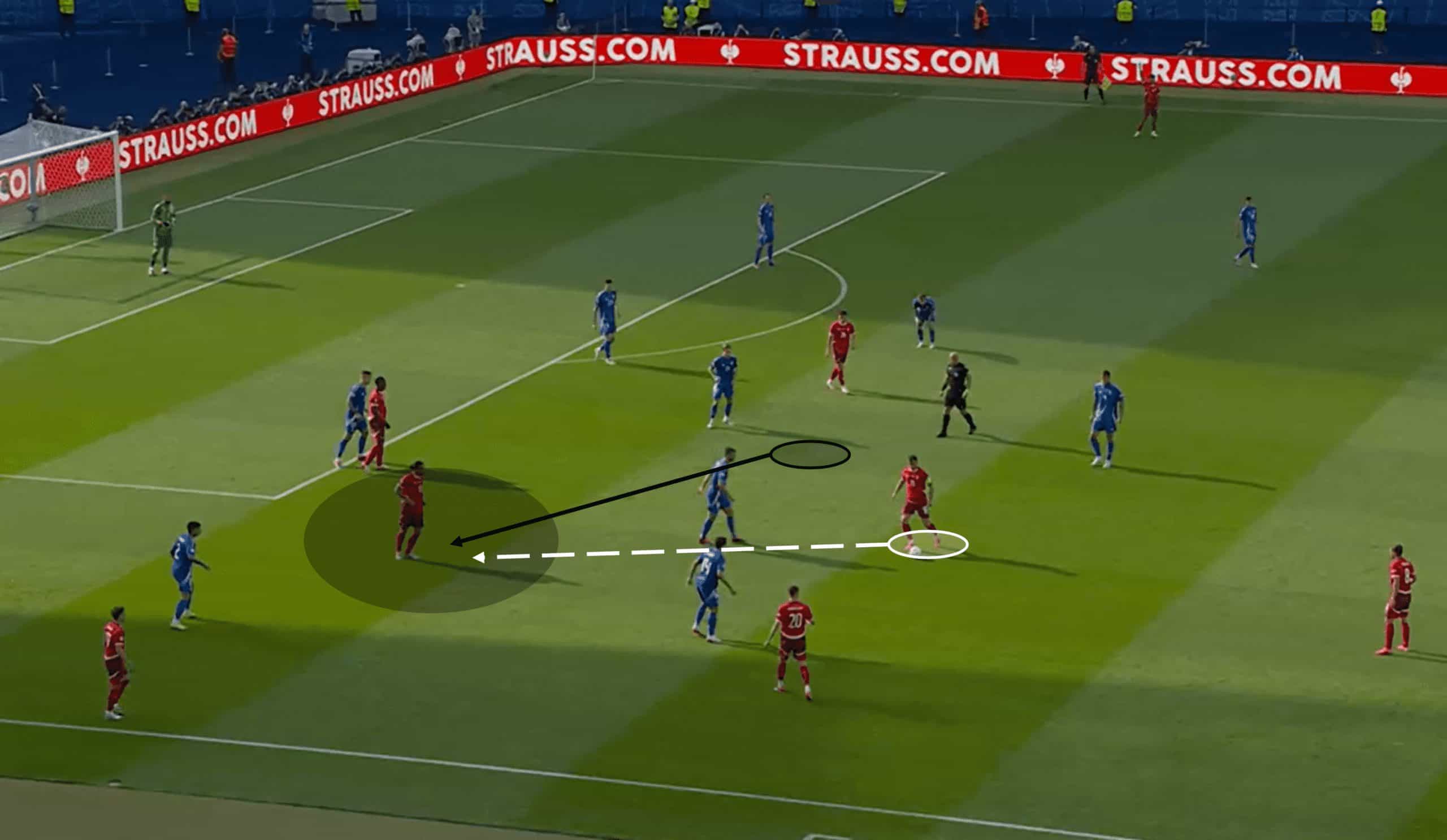
This example did not result in a goal but highlights the attention to detail within Switzerland’s attacking tactics. National veteran Ricardo Rodríguez has, as well know, excellent qualities to lend to Switzerland in build-up play, and that goes further than just technical aspects of his game.
Following a scan from the left-back, he noticed two key factors – he was totally unmarked in his initial position but wasn’t in the best position to help his teammate. To rectify that, he simply drifted into the position you see above – ahead of the ball on a clear passing line for his teammate. Receiving the ball in a position like that comes with multiple next options – run at the Italy backline as the two nearest defenders are marking other Swiss shirts; alternatively, double up on of those defenders and look to execute a combination/link-up play with the corresponding teammate.
And that is why we have highlighted Switzerland’s off-the-ball movement in the final third – they have multiple individuals who possess the understanding and the timing of these runs and movements to either finish an attack or progress it.
Chance creation via through passes
If you check the data, you’ll see that Switzerland don’t make that many crosses or long passes, but they’ve shown a clear attacking quality this tournament. While they do create chances on the back of clever movements, as we just discussed, they also like to utilise through passes. At this moment, they’ve averaged 6.71 through passes per 90 at the Euros this year – only five teams have a higher engagement with through balls.
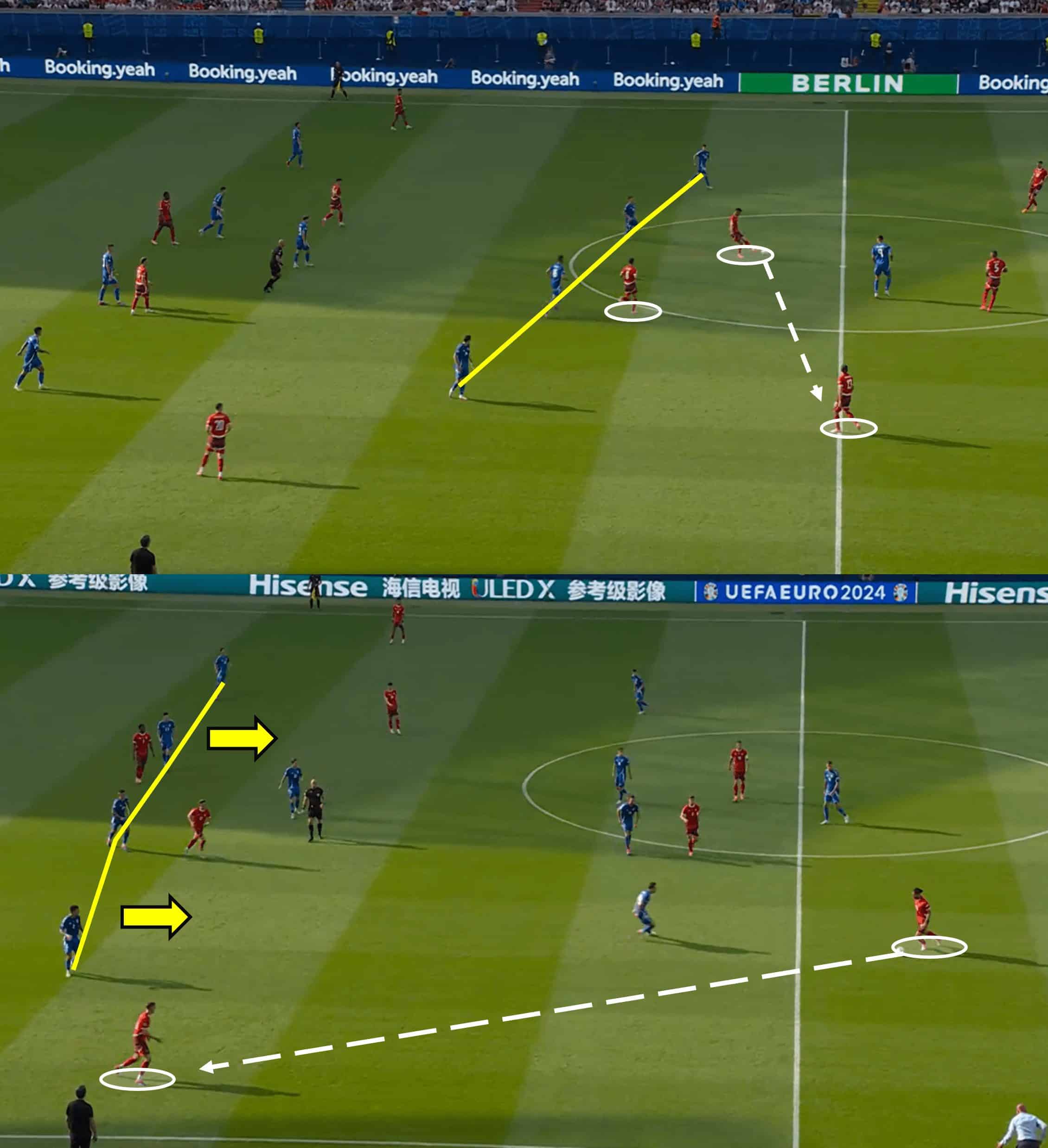
While Switzerland didn’t dominate possession overall against Italy, they did approach possession patiently. Playing against an Italian mid-block, the Swiss knew that their chances of playing their way through their opponents with a fluid approach featuring short passes were slim.
In those early phases of possession, this patient aimed to draw Italy out, even slightly, to create space in midfield or behind the backline. The image above provides an example of this—patient passing at the back until Italy’s midfield looks to step up the pressure. However, Switzerland’s attacking presence beyond Italy’s midfield is ready and waiting for that ball to come through. The width in attack that we mentioned earlier comes in extremely handy here.
As that ball goes into midfield/out wide past the Italy midfield, the Italian defence feels a sense of urgency, as they feel the need to step up to try and squeeze Switzerland. However, as you can see from the next image, their defensive organisation severely let them down on this occasion.
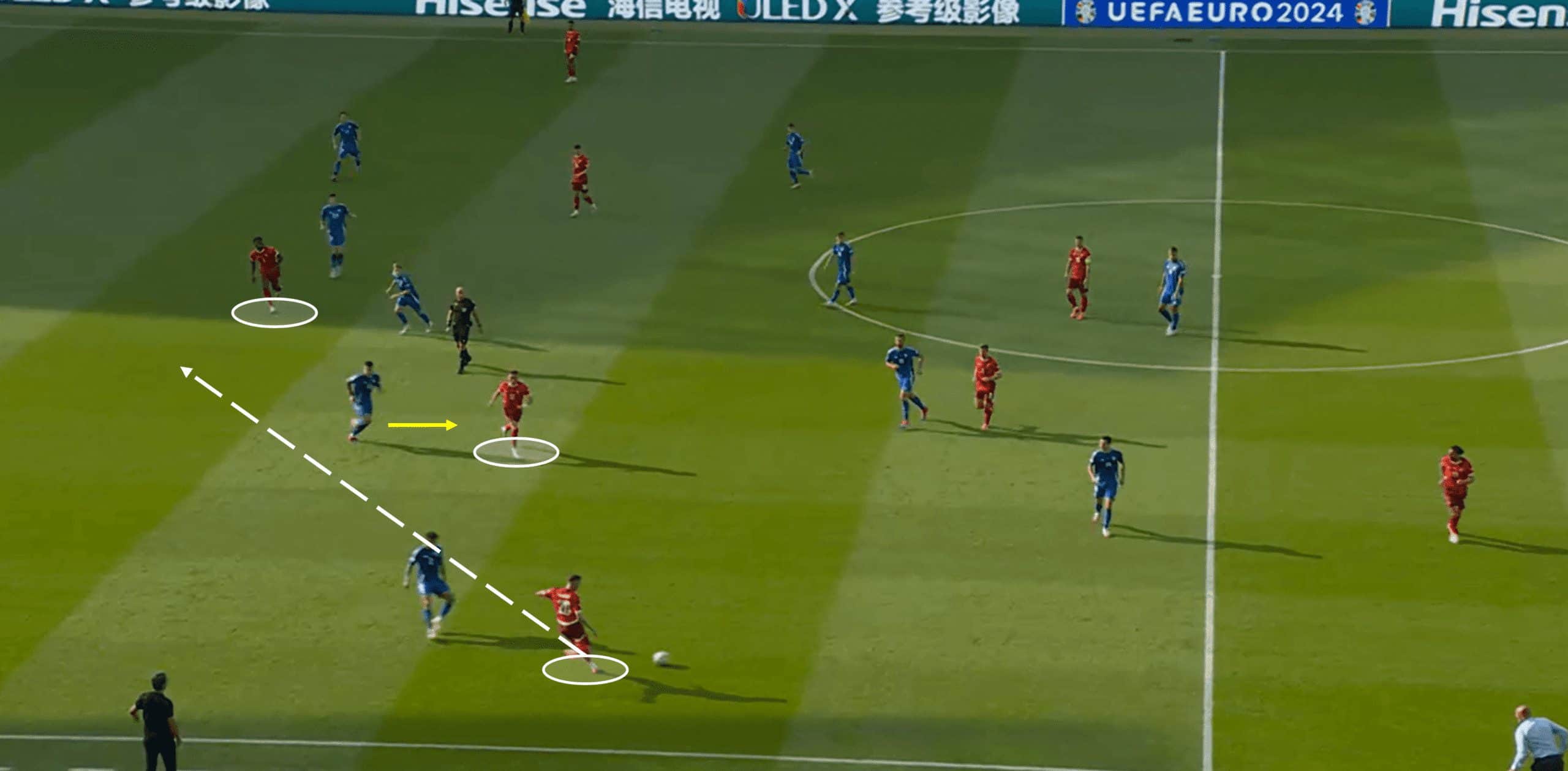
It is difficult to know where to start with that Italian backline—half of them have pushed up to press the ball and mark the immediate passing option, while the other half haven’t moved from their initial position. This is a grave mistake against any opponent in this competition, but it is unforgivable against a team known for its deadly attack and ability to punish defensive weaknesses.
From Switzerland’s perspective, they moved the ball well into that wide area, and the Swiss midfielder had the ability to know his teammate would be making that exact run in behind the defence, and the quality of the pass was excellent, too. Breel Embolo will only be disappointed that he could finish the attack with a goal. Still, this is just one example of Switzerland carving teams open with a through pass.
Conclusion
As we mentioned, this win from the Swiss was EURO 2024’s first and, so far, only upset in the knockout phase. That is in no way a slight at Switzerland’s quality, but they were facing the reigning champions, and many fancied them to make it to the next round – many underestimated Switzerland.
As you will know, their next opponent in this competition is England, with a spot in the semi-finals up for grabs. This game won’t be easy for either team; on paper, it is England’s biggest test so far in the tournament. England’s backline will have to be on high alert to deal with Switzerland’s through balls and clever movement in the final third; otherwise, they could be waving goodbye to another trophy.






Comments